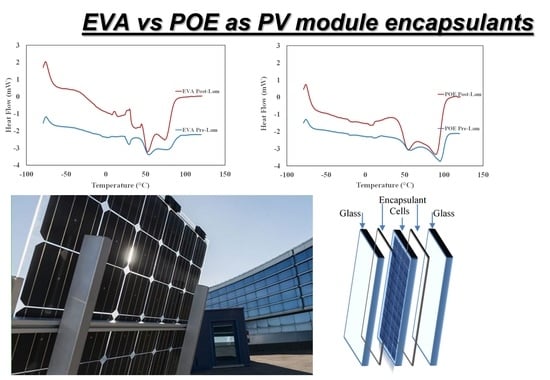Durability and Performance of Encapsulant Films for Bifacial Heterojunction Photovoltaic Modules
Abstract
:1. Introduction
2. Materials and Methods
2.1. Materials
2.2. Characterizations
- Differential Scanning Calorimetry: The calorimetric data were evaluated by differential scanning calorimetry (DSC) using a DSC60-Shimadzu calorimeter. All experiments were performed under dry nitrogen on samples of about 10 mg in 40 μL sealed aluminum pans. For both EVA and POE, the calorimetric scans, heating: from −80 to 120 °C and cooling: from 120 to −80 °C, were performed for each sample at scanning heating/cooling rate of 10 °C/min. The values of heat flow have been normalized considering sample mass.
- Rheological analysis: Rheological tests were performed using a stress-controlled rheometer (Rheometric Scientific, SR5, mod. ARES G2 by TA Instrument, New Castle, DE, USA) in parallel plate geometry (plate diameter 25 mm). The complex viscosity (η*), storage (G’) and loss (G”) moduli were measured under frequency scans from ω = 10 − 1 to 102 rad/s at T = 140 °C and T = 170 °C for EVA and POE, respectively. The strain amplitude was γ = 5%, which preliminary strain sweep experiments proved to be low enough to be in the linear viscoelastic regime.
- FTIR Spectroscopy: A Fourier Transform Infrared Spectrometer (Spectrum One, Perkin Elmer) was used to record IR spectra using 16 scans at a resolution of 1 cm−1. ATR-FTIR for some surface analysis has been also carried out, using 16 scans at a resolution of 1 cm−1. The progress of both photo- and thermo-oxidation degradation for EVA and POE has been followed by running FTIR analysis with time and monitoring the variations in the hydroxyl range (3200–3600 cm−1) and carbonyl range (1800–1500 cm−1) in time, using Spectrum One software.
- UV-visible Spectrometer, (Specord®250 Plus, Analytikjena, Torre Boldone, Italy), was used to record UV-Vis spectra performing 8 scans between 200 and 1100 nm at a resolution of 1 nm. The values of linear attenuation coefficient (k) were calculated considering the measured absorption values (A) and sample thickness (D), using the formula: k = A/(2.3D).
2.3. Accelerated Weathering and Thermo-Oxidation
3. Results
3.1. Differential Scanning Calorimetry (DSC) Characterization
3.2. Rheological Characterization
3.3. Mechanical Characterization
3.4. UV-Visible Characterization
3.5. FTIR Characterization
3.6. Photoxidation Resistance
3.7. Thermo-Oxidation Resistance
4. Conclusions
Author Contributions
Funding
Institutional Review Board Statement
Informed Consent Statement
Data Availability Statement
Acknowledgments
Conflicts of Interest
References
- Farrell, C.; Osman, A.I.; Zhang, X.; Murphy, A.; Doherty, R.; Morgan, K.; Rooney, D.W.; Harrison, J.; Coulter, R.; Shen, D. Assessment of the energy recovery potential of waste Photovoltaic (PV) modules. Sci. Rep. 2019, 9, 5267. [Google Scholar] [CrossRef] [PubMed] [Green Version]
- Cattaneo, G.; Levrat, J.; Li, H.; Barth, V.; Sicot, L.; Richter, A.; Colletti, C.; Rametta, F.; Izzi, M.; Despeisse, M.; et al. Encapsulant Materials for High Reliable Bifacial Heterojunction Glass/Glass Photovoltaic Modules. In Proceedings of the 47th IEEE Photovoltaic Specialists Conference, PVSC 2020, Calgary, AB, Canada, 15 June–21 August 2020. [Google Scholar] [CrossRef]
- Kempe, M. Evaluation of encapsulant materials for PV application. Photovolt. Int. Pap. 2010, 9. Available online: https://www.osti.gov/biblio/1049592 (accessed on 20 February 2022).
- Pern, J. Module encapsulation materials, processing and testing. APP Int. PV Reliab. Workshop 2008. Available online: https://www.nrel.gov/docs/fy09osti/44666.pdf (accessed on 20 February 2022).
- Pern, F.J. EVA encapsulants for photovoltaic modules: Degradation and discoloration mechanisms and formulation modifi-cations for improved photostability. Die Angew. Makromol. Chem. 1997, 252, 195–216. [Google Scholar] [CrossRef]
- Cuddihy, E.F.; Coulbert, C.; Gupla, A.; Liang, R. Flat-Plate Solar Array Project Final Report; Module Encapsulation; JPL Publication: Pasadena, CA, USA, 1986; Volume VII. [Google Scholar]
- Cuddihy, E.F.; Coulbcrt, C.D.; Willis, P.; Baum, B.; Garcia, A.; Miming, C.; Ccbelein, C.G.; Williams, D.J.; Dcanin, R.D. Polymers in Slur Energv Ufilizafion; ACS: Washington, DC, USA, 1983; Chapter 22; pp. 353–366. [Google Scholar]
- Gaume, J.; Taviot-Gueho, C.; Cros, S.; Rivaton, A.; Thérias, S.; Gardette, J.-L. Optimization of PVA clay nanocomposite for ultra-barrier multilayer encapsulation of organic solar cells. Sol. Energy Mater. Sol. Cells 2012, 99, 240–249. [Google Scholar] [CrossRef]
- Kempe, M. Overview of Scientific Issues Involved in Selection of Polymers for PV Applications. In Proceedings of the 37th IEEE Photovoltaic Specialists Conference National Renewable Energy Laboratory, Seattle, WA, USA, 19–24 June 2011. [Google Scholar] [CrossRef]
- Jorgensen, G.J.; McMahon, T.J. Accelerated and outdoor aging effects on photovoltaic module interfacial adhesion properties. Prog. Photovolt. Res. Appl. 2008, 16, 519–527. [Google Scholar] [CrossRef]
- Green, M.A. Silicon photovoltaic modules: A brief history of the first 50 years. Prog. Photovolt. Res. Appl. 2005, 13, 447–455. [Google Scholar] [CrossRef]
- Hirschl, C.; Biebl–Rydlo, M.; DeBiasio, M.; Mühleisen, W.; Neumaier, L.; Scherf, W.; Oreski, G.; Eder, G.; Chernev, B.; Schwab, W.; et al. Determining the degree of crosslinking of ethylene vinyl acetate photovoltaic module encapsulants—A comparative study. Sol. Energy Mater. Sol. Cells 2013, 116, 203–218. [Google Scholar] [CrossRef] [Green Version]
- Chapuis, V.; Pelisset, S.; Raeis-Barneoud, M.; Li, H.-Y.; Ballif, C.; Perret-Aebi, L.-E. Compressive-shear adhesion characterization of PVB and EVA at different curing times before and after exposure to damp-heat conditions. Prog. Photovolt. Res. Appl. 2014, 22, 405–414. Available online: https://onlinelibrary.wiley.com/doi/10.1002/pip.2270 (accessed on 20 February 2022). [CrossRef] [Green Version]
- Pern, F. Factors that affect the EVA encapsulant discoloration rate upon accelerated exposure. Sol. Energy Mater. Sol. Cells 1996, 41–42, 587–615. [Google Scholar] [CrossRef]
- Pern, F.J.; Glick, S.H. Thermal processing of EVA encapsulants and effects of formulation additives. In Proceedings of the Conference Record of the Twenty Fifth IEEE Photovoltaic Specialists Conference—1996, Washington, DC, USA, 13–17 May 1996. [Google Scholar] [CrossRef]
- La Mantia, F.; Malatesta, V.; Ceraulo, M.; Mistretta, M.; Koci, P. Photooxidation and photostabilization of EVA and cross-linked EVA. Polym. Test. 2016, 51, 6–12. [Google Scholar] [CrossRef]
- Kempe, M.D.; Jorgensen, G.J.; Terwilliger, K.M.; McMahon, T.J.; Kennedy, C.E.; Borek, T.T. Acetic Acid Production A and Glass Transition Concerns with Ethylene-Vinyl Acetate Used in Photovoltaic Devices. Sol. Energy Mater. Sol. Cells 2007, 91, 315–329. [Google Scholar] [CrossRef]
- Wenger, H.; Schaefer, J.; Rosenthal, A.; Hammond, B.; Schlueter, L. Decline of the Carrisa Plains PV power plant: The impact of concentrating sunlight on flat plates. In Proceedings of the Conference Record of the Twenty-Second IEEE Photovoltaic Specialists Conference—1991, Las Vegas, NV, USA, 7–11 October 1991; pp. 586–592. [Google Scholar] [CrossRef]
- Rosenthal, A.L.; Lane, C.G. Field test results for the 6 MW Carrizo solar photovoltaic power plant. Sol. Cells 1991, 30, 563–571. [Google Scholar] [CrossRef]
- Baiamonte, M.; Therias, S.; Gardette, J.-L.; Colletti, C.; Dintcheva, N.T. Encapsulant polymer blend films for bifacial heterojunction photovoltaic modules: Formulation, characterization and durability. Polym. Degrad. Stab. 2021, 193, 109716. [Google Scholar] [CrossRef]
- de Oliveira, M.C.C.; Cardoso, A.S.A.D.; Viana, M.M.; Lins, V.D.F.C. The causes and effects of degradation of encapsulant ethylene vinyl acetate copolymer (EVA) in crystalline silicon photovoltaic modules: A review. Renew. Sustain. Energy Rev. 2018, 81, 2299–2317. [Google Scholar] [CrossRef]
- Jin, J.; Chen, S.; Zhang, J. UV aging behaviour of ethylene-vinyl acetate copolymers (EVA) with different vinyl acetate contents. Polym. Degrad. Stab. 2010, 95, 725–732. [Google Scholar] [CrossRef]
- Dintcheva, N.T.; La Mantia, F.P.; Scaffaro, R.; Paci, M.; Acierno, D.; Camino, G. Reprocessing and restabilization of greenhouse films. Polym. Degrad. Stab. 2002, 75, 459–464. [Google Scholar] [CrossRef]
- La Mantia, F.P.; Dintcheva, N.T. Re-Gradation of Photo-Oxidized Post-Consumer Greenhouse Films. Macromol. Rapid Commun. 2005, 26, 361–364. [Google Scholar] [CrossRef]
- Allen, N.S. (Ed.) Photodegradation Processes in Polymeric Materials. In Photochemistry and Photophysics of Polymer Materials; John Wiley & Sons, Inc.: Hoboken, NJ, USA, 2010; pp. 569–601. [Google Scholar]


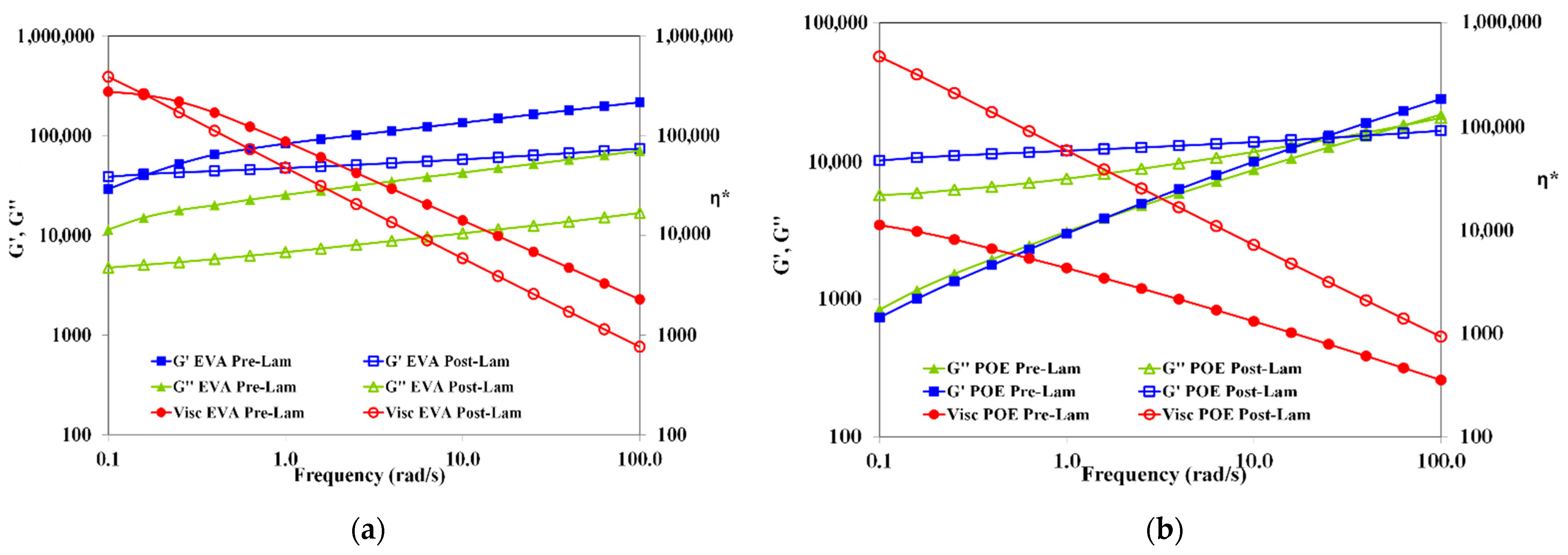

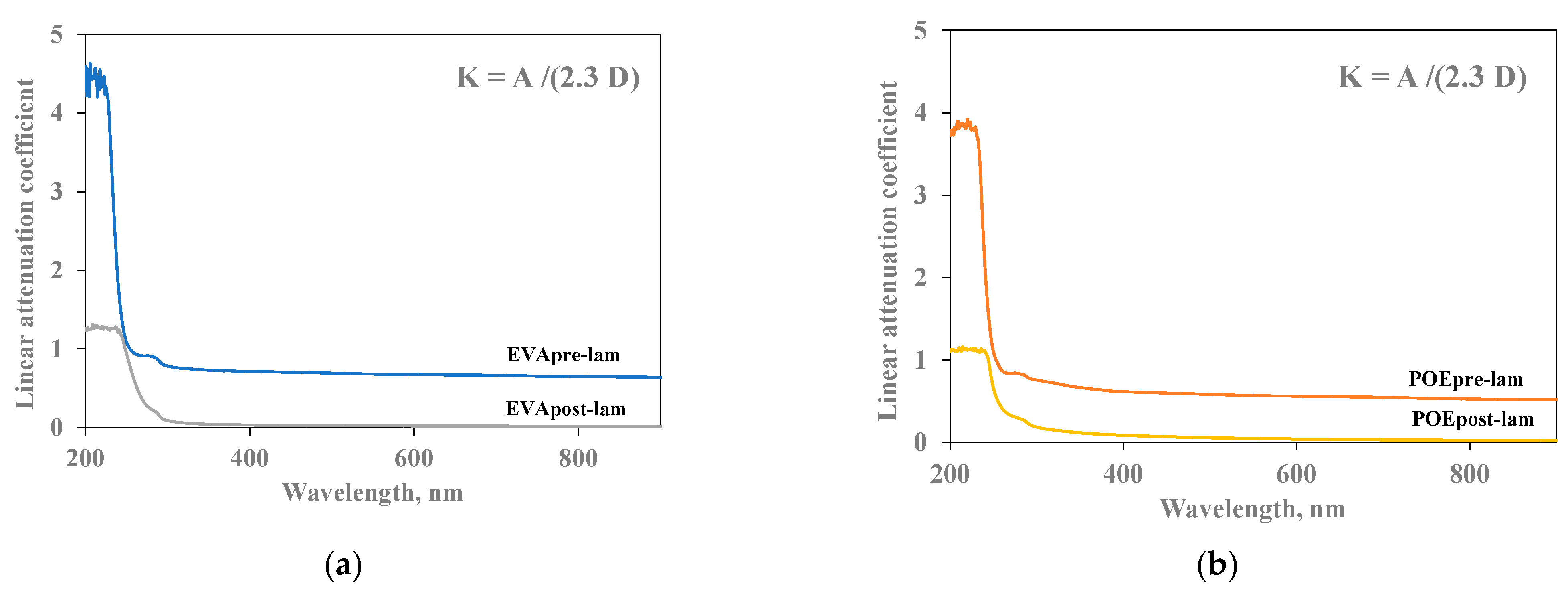

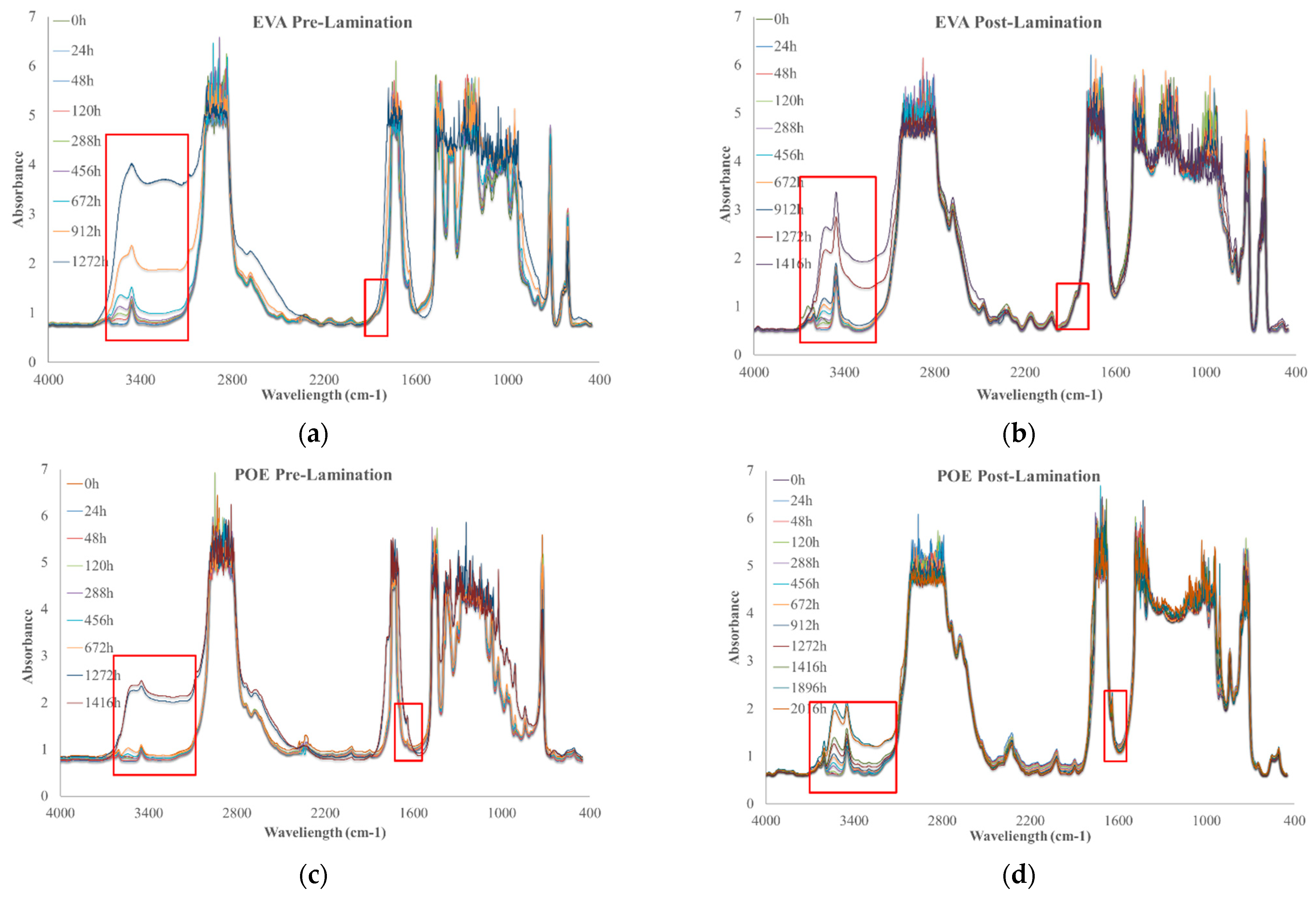


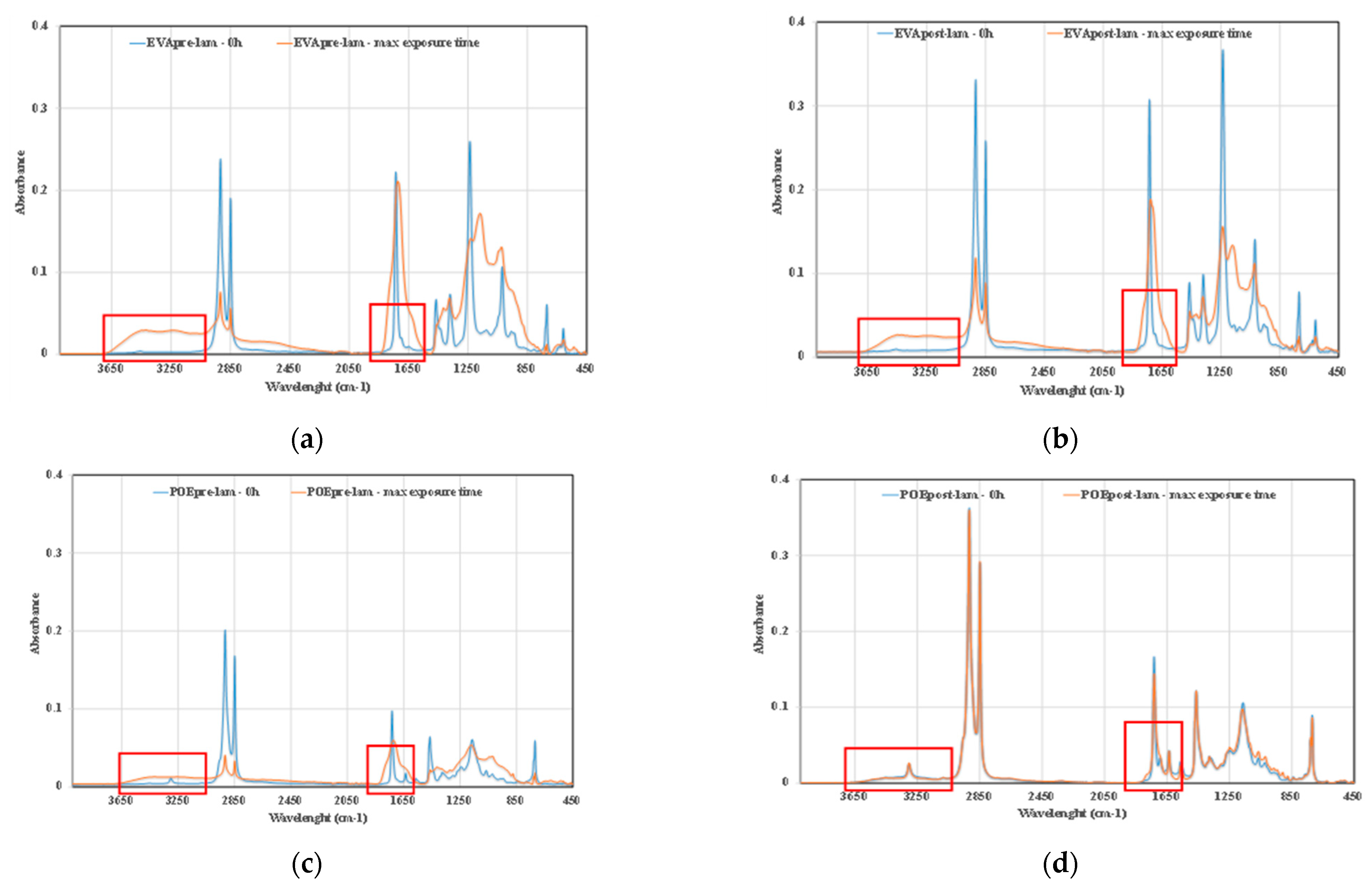

| Glass Transition | Exothermic Phenomenon | Endothermic Phenomenon | ||||
|---|---|---|---|---|---|---|
| Tg, °C | Tc, °C | Tf1, °C | Tf2, °C | Tf3, °C | ΔH, J/g | |
| EVApre-lam | −66.9 | 5.27 | 29.92 | 54.78 | 78.77 | 12.32 |
| EVApost-lam | −63.0 | 8.15/25.40 (*) | 37.32 | 51.45 | 73.16 | 32.13 |
| POEpre-lam | −67.4 | 12.02 | 29.26 | 58.36 | 78.11 | 12.54 |
| POEpost-lam | −62.6 | 7.06 | 37.66 | 55.03 | 74.49 | 46.83 |
| E, MPa | TS, MPa | EB, % | |
|---|---|---|---|
| EVApre-lam | 11.6 ± 0.7 | 4.9 ± 0.3 | 725 ± 45 |
| EVApost-lam | 16.5 ± 1.2 | 8.3 ± 0.5 | 441 ± 27 |
| POEpre-lam | 21.4 ± 1.5 | 4.9 ± 0.3 | 550 ± 25 |
| POEpost-lam | 31.6 ± 2.5 | 7.3 ± 0.5 | 567 ± 25 |
Publisher’s Note: MDPI stays neutral with regard to jurisdictional claims in published maps and institutional affiliations. |
© 2022 by the authors. Licensee MDPI, Basel, Switzerland. This article is an open access article distributed under the terms and conditions of the Creative Commons Attribution (CC BY) license (https://creativecommons.org/licenses/by/4.0/).
Share and Cite
Baiamonte, M.; Colletti, C.; Ragonesi, A.; Gerardi, C.; Dintcheva, N.T. Durability and Performance of Encapsulant Films for Bifacial Heterojunction Photovoltaic Modules. Polymers 2022, 14, 1052. https://doi.org/10.3390/polym14051052
Baiamonte M, Colletti C, Ragonesi A, Gerardi C, Dintcheva NT. Durability and Performance of Encapsulant Films for Bifacial Heterojunction Photovoltaic Modules. Polymers. 2022; 14(5):1052. https://doi.org/10.3390/polym14051052
Chicago/Turabian StyleBaiamonte, Marilena, Claudio Colletti, Antonino Ragonesi, Cosimo Gerardi, and Nadka Tz. Dintcheva. 2022. "Durability and Performance of Encapsulant Films for Bifacial Heterojunction Photovoltaic Modules" Polymers 14, no. 5: 1052. https://doi.org/10.3390/polym14051052
APA StyleBaiamonte, M., Colletti, C., Ragonesi, A., Gerardi, C., & Dintcheva, N. T. (2022). Durability and Performance of Encapsulant Films for Bifacial Heterojunction Photovoltaic Modules. Polymers, 14(5), 1052. https://doi.org/10.3390/polym14051052






